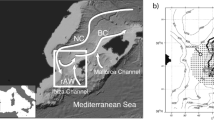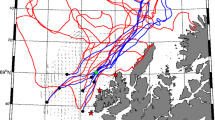Summary
Surface currents, as measured by the HF-radar CODAR (COstal raDAR), are investigated with respect to their dependence on wind. Time series of wind are available from single weather stations, while CODAR yields current velocities on a grid with a resolution of some 3 km. As part of various research programs experiments have been carried out by the University of Hamburg (Germany) in different areas. Two of the areas under consideration are located in the Baltic Sea, two in the North Sea, and one covering the northern part of the Dead Sea. Time series of about two weeks with 2-hourly sampling are available for some 50 grid points of each area.
Vector-correlation techniques are used to determine the linear relation of surface currents on wind velocity and also windstress. In both cases, significant correlation of about the same order has been found. 35% to 60% of the variance in surface currents may be explained by linear forcing from the vectors of wind velocity or windstress. Current-to-wind ratios range from 0.015 to 0.025, and a veering to the right of currents against wind has been observed. The decomposition of horizontal two-dimensional current fields into empirical orthogonal eigenfunctions (EOF) yields higher amounts of variance in the 1. EOF as may be explained by linear windforcing.
Two possible mechanisms for wind-driven currents are discussed, Ekman circulation and Stokes drift. Assuming the vertical eddy viscosity to be independent on wind velocity and water depth, it may be estimated. Values of about 5×10−4 m2s−1 are found in the Baltic and 20×10−4 m2s−1 in the North Sea, which are in reasonable agreement with those used in numerical models.
Zusammenfassung
Oberflächenströmungen, gemessen mit dem Hochfrequenzradar CODAR (COastal RaDAR), werden hinsichtlich ihrer Windabhängigkeit untersucht. CODAR mißt Strömungsgeschwindigkeiten in einem Gitter mit 3 km Auflösung. Zeitserien des Windes stammen von naheliegenden Wetterstationen. Messungen wurden von der Universität Hamburg im Rahmen von Forschungsprojekten in verschiedenen Meeresgebieten durchgeführt. Zwei dieser Gebiete liegen in der Ostsee, zwei in der Nordsee und eines umfaßt den nördlichen Teil des Toten Meeres. Von allen Gebieten existieren Meßserien an etwa 50 Gitterpunkten mit zweistündiger Abtastung und etwa 2 Wochen Dauer.
Zur Bestimmung der linearen Abhängigkeit der Strömung sowohl vom Wind als auch vom Windschub werden Vektorkorrelationen berechnet. In beiden Fällen ergibt sich eine signifikante Korrelation von etwa gleichem Betrag. 35% bis 60% der Varianz der Oberflächenströmungen kann durch linearen Antrieb des Windes oder Windschubes erklärt werden. Der Quotient von Strömungs- zu Windgeschwindigkeit liegt im Bereich 0,015 bis 0,025, und es ist eine Drehung der Strömung nach rechts gegenüber dem Wind zu beobachten. Die Zerlegung des zweidimensionalen Strömungsfeldes in EOFs (empirical orthogonal eigenfunctions) ergibt für die 1. EOF einen höheren Varianzanteil als durch linearen Windantrieb erklärt werden kann.
Zwei unterschiedliche Antriebsmechanismen für winderzeugte Strömungen werden diskutiert, Ekman Zirkulation und Stokes Drift. Der vertikale Austauschkoeffizient kann aus Daten bestimmt werden, vorausgesetzt daß er nicht vom Wind und der Wassertiefe abhängt. Werte von etwa 5×10−4 m2s−1 werden für die Ostsee und 20×10−4 m2s−1 für die Nordsee gefunden. Diese Werte liegen in dem Bereich, der für numerische Modelle benutzt wird.
Résumé
Les courants de surface mesurés par le radar CODAR (COastal raDAR), sont analysés par rapport à leur dépendence vis-à-vis du vent. Les séries temporelles du vent sont disponibles á chaque station météorologique alors que CODAR donne les vitesses des courants sur une grille de 3 km de résolution. Dans le cadre de plusieurs programmes de recherche, des études ont été faites par l'Université de Hamburg (Allemagne) dans différents endroits. Deux des zones considérées sont situées dans la Mer Baltique, deux dans la Mer du Nord et une couvre la partie Nord de la Mer Morte. Des séries temporelles d'environ 2 semaines avec un échantillonnage de 2-heures sont disponibles sur 50 points pour chaque zone.
Des techniques de correlation vectorielle sont employées pour déterminer la relation linéaire entre courants de surface et d'une part la vitesse et d'autre part la pousée du vent. Dans les deux cas nous avons trouvé une correlation significative du même ordre. Le modèle linéaire forcé par les vecteurs de vitesse et pousée de vent représente de 35%–60% de la variance des courants de surface. Les rapports courant-vent varient de 0.015–0.025 et la rotation vers la droite des courants par rapport au vent a été observée. La décomposition des champs bi-dimensionnels de courant sur des fonctions propres empiriques orthogonales (EOF) donnent des taux de variance plus importants dans la lère EOF, comme expliqué par le forçage linéaire du vent.
Deux mécanismes possibles de courants induits par les vents sont discutés, la circulation d'Ekman et la dérive de Stokes. Supposant une viscosité de tourbillon verticale indépendente de la vitesse du vent et de la profondeur, la viscosité est estimée. Des valeurs d'environ 5×10−4 m2s−1 et de 20×10−4 m2s−1 sont trouvées respectivement pour la Mer Baltique et la Mer du Nord, ce qui est en accord raisonable avec les valeurs utilisées dans les modèles numériques.
Similar content being viewed by others
References
Barrick, D.E., M.W. Evans and B.L. Weber, 1977: Ocean surface currents, mapped by radar. Science198, 138–144.
Ekman, V.W., 1905: On the influence of the earth's rotation on ocean currents. Ark. Mat. Astron. Fys.2, 1–53.
Essen, H.-H., K.-W. Gurgel and F. Schirmer, 1983: Tidal and wind-driven parts of surface currents, as measured by radar. Dt. Hydrogr. Z.36, 82–96.
Essen, H.-H., T. Freygang, K.-W. Gurgel and F. Schirmer, 1984: Oberflächenströmungen vor Sylt-Radarmessungen im Herbst 1983. Dt. Hydrogr. Z.37, 201–215.
Essen, H.-H., K.-W. Gurgel and F. Schirmer, 1988: Horizontal and temporal variability of surface currents in the “Lübecker Bucht”, as measured by radar. Dt. Hydrogr. Z.41, 57–74.
Essen, H.-H., K.-W. Gurgel and F. Schirmer, 1989: Surface currents in the Norwegian Channel measured by radar in March 1985. Tellus41A, 162–174.
Federov, K.N. and A.I. Ginsburg, 1992: The near-surface layer of the ocean. VSP, Utrecht (The Netherlands).
Kenyon, K.K., 1969: Stokes drift for random gravity waves. J. Geoph. Res.74, 6691–6694.
Kirwan, A.D., G. McNally, S. Pazan and R. Wert, 1979: Analysis of surface current to wind. J. Phys. Ocean.9, 401–412.
Kundu, P.K., 1976: Ekman veering observed near the ocean bottom. J. Phys. Ocean.6, 238–242.
Kundu, P.K. and J.S. Allen, 1976: Some three-dimensional characteristics of low-frequency current fluctuations near the Oregon coast. J. Phys. Oceanogr.6, 181–199.
McNally, G.J., D.S. Luther and W.B. White, 1989: Subinertial frequency response of wind-driven currents in the mixed layer measured by drifting buoys in the midlatitude North Pacific. J. Phys. Ocean.19, 290–300.
Pedlosky, J., 1987: Geophysical Fluid Dynamics, 2. ed. New York: Springer.
Pierson, W.J. and L. Moskowitz, 1964: A proposed spectral form for fully developed wind seas based on the similarity theory of S. A. Kitaigorodskii. J. Geophys. Res.69, 5181–5190.
Pond, S. and G.L. Pickard, 1978: Introductory Dynamic Oceanography. Oxford: Pergamon Press.
Sirkes, Z., F. Schirmer, H.-H. Essen and K.-W. Gurgel, 1992: Surface currents in the Dead Sea measured by Radar, Israel Journal of Earth Science. In print.
Steward, R.H. and J.W. Joy, 1974: HF ratio measurements of surface currents, Deep-Sea Res.21, 1039–1049.
Author information
Authors and Affiliations
Rights and permissions
About this article
Cite this article
Essen, HH. Ekman portion of surface currents, as measured by radar in different areas. Deutsche Hydrographische Zeitschrift 45, 57–85 (1993). https://doi.org/10.1007/BF02226315
Received:
Accepted:
Published:
Issue Date:
DOI: https://doi.org/10.1007/BF02226315




